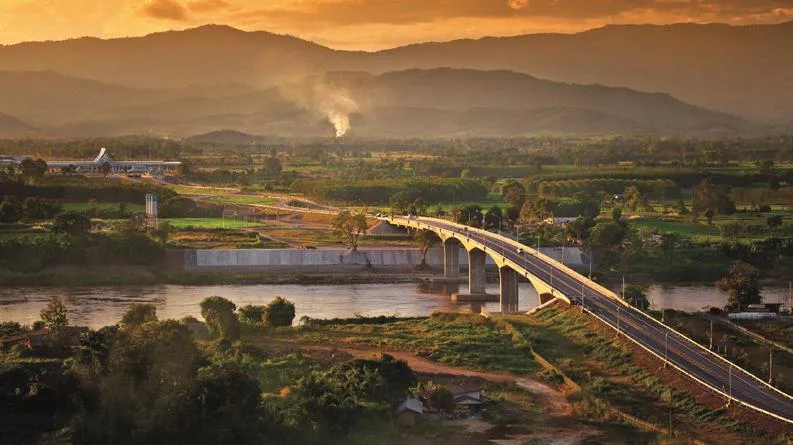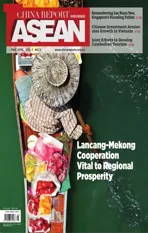LMC Connects Regional Interests
2016-09-26ByLuGuangsheng
By Lu Guangsheng
LMC Connects Regional Interests
By Lu Guangsheng

Chiang Khong-Houayxay Bridge on the Mekong River, connecting Thailand with Laos, jointly built by China, Laos and Thailand
the first Lancang-Mekong Cooperation(LMC) Leaders’ Meeting, held in Sanya in China’s Hainan Province on March 23, represents a key first step in setting the tone of development and cooperation in the region.
Chinese Premier Li Keqiang attended the talks alongside high-ranking leaders from each of the countries lying in the Mekong basin-Thailand, Cambodia, Laos, Myanmar and Vietnam. the LMC was officially established in November 2015, but it was not until late March that leaders from each nation sat down for face-to-face talks.
Before the establishment of the LMC, a number of sub-regional cooperation initiatives had already been started, including the Greater Mekong Sub-regional (GMS) forum for economic cooperation and the Mekong Regional Committee (MRC). However, several differences remain between the LMC and existing mechanisms for cooperation.
First, the LMC was jointly established by representatives of each country, while the GMS was backed by the Asian Development Bank (ADB). In addition, the LMC covers areas of politics, security, economic development, society and culture, while the GMS focuses primarily on economic development. In the past 20 years, the GMS has been actively pursuing economic cooperation,especially in areas of infrastructure and connectivity. However, efforts in political and cultural exchanges have been lacking. As Southeast Asia develops, it needs more.
China was active in promoting the es-tablishment of the LMC for several reasons. First, the existing GMS and MRC mechanisms do not other enough regional support in areas beyond economic development. China’s Belt and Road initiative-a series of infrastructure projects designed to link East Asia, Southeast Asia, Central Asia and Europe-requires better coordination among ASEAN countries, particularly those in the Mekong Region.
China intends to improve its cooperation with ASEAN countries (especially those in the Mekong Region), in areas of politics, security and culture. The Asian Infrastructure Investment Bank (AIIB) and the Silk Road Fund give China an opportunity to contribute more financially to regional cooperation ethorts.
Some in ASEAN countries may harbor concern about the impact China will have on ASEAN integration ethorts. Given historical precedents, I am positive that China’s impact will be one of mutual benefit. Regional cooperation in ASEAN and East Asia has long carried characteristics of openness, and countries have resisted exclusivity. therefore,similar to the GMS, the LMC will not have a negative impact on ASEAN.
In fact, the LMC may even be conducive to ASEAN integration, and will certainly be a boost to China-ASEAN relations. China and ASEAN economic cooperation is approaching a zone of “zero tariffs” as trade barriers fall. Economic ties continue to deepen further and it is inevitable that the need for strengthened cooperation in politics and culture will intensify. the LMC mechanism for cooperation was built upon a solid foundation with high levels of political confidence, and is geared toward cooperation in “problem areas” of security and water resources. LMC Cooperation can serve as an example to the rest of the developing world, particularly as countries of the Mekong sub-region are lagging behind in ASEAN integration. Should the LMC be able to accelerate economic development and expand markets within the region, ASEAN integration should happen more quickly.
The theme of the first meeting of LMC leaders was that of a “shared river, shared future”. In contrast, the GMS has long used the slogan of a “shared river”, but without the idea of mutual benefit, cooperation and growth championed by China in recent years-hence the “shared future” addition to the LMC’s tagline. China has advocated ditherent versionsof its principle of a “Community of Shared Future”, including a version suited toward China’s engagement with ASEAN countries.the Lancang-Mekong Six (LM6) Community of Shared Future goes even further, built upon a sold foundation of concrete plans.
In the past few months, Mekong basin countries have suthered from severe drought. Vietnam, for one, has asked China to allow more water to pass through the Lancang,into the Mekong. China responded swiftly,increasing the amount of water flowing downstream and providing a key example of new efforts in this Southeast Asian“Community of Shared Future”.
How will the LMC evolve in the future?I believe that the LMC will not replace existing forums for cooperation like the GMS. Instead, the two initiatives will combine to become a multi-faceted approach for further promotion and development of regional cooperation. Secondly, the LMC will become involved in more “economy plus” cooperation, with an emphasis on “upgraded” and“green” development. In the fields of politics and security, the partners will look to further intensify high level exchanges among leaders, political parties and private citizens, in an ethort to enhance mutual trust.
Cooperation in border areas, too, will be strengthened, particularly in the face of new,non-traditional threats. In terms of societal and cultural cooperation, China as well as ASEAN member states are exploring the feasibility of the construction of interactive cultural centers, serving to educate citizens about their neighbors. Some early projects are set to be started quite soon, which will lead to visible and tangible results that will focus on the areas of connectivity, production capacity, cross-border economic cooperation, water resources, agriculture and poverty reduction.
The implementation of these early projects will mark the start of an exciting time in the Mekong River basin, as the LMC lays a solid foundation for further cooperation.

Port of Daluo in Xishuangbanna, connecting China with Myanmar
About the author:
Lu Guangsheng is the Dean of Southeast Asian Studies at Yunnan University.
